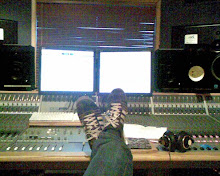I finally moved up to Protools 7.4 for one thing.
I'd gotten 7.4 with my new Lightbridge, but as luck would have it, I ended up having to pay for the updgrade anyway because you have to have the same version of LE and M-Powered to run the two on one PC.
Glorious.
So I'm stuck with having to buy upgrades for both until I ditch the 002 altogether.
Although I haven't gotten around to checking out all the new stuff, Elastic Audio is definitely worth a mention.
I had a chance to test it out on two different tunes - one that was pretty tight already but suited the welded to the grid thing, and another than was pretty much the opposite.
In both cases it did a pretty fine job once I'd gotten the hang of it.
It seems to do its best work on drums, and editing them this way is a relatively painless undertaking.
I did run into some trouble where I had guitar tracks that consisted of two microphones on one amp with the diaphragms as close together as possible for phase reasons.
On these tracks the shifting and warping would occasionaly knock the two mics out of phase with each other - I can only assume that this is happening across a group of drum tracks too, but with less readily audible results. Then again, it could be my elastic noobness letting me down (hints and tricks appreciated).

In new plugin news, I've been demoing the Abbey Road Brilliance Pack.
This consists of three plugins, all of which are based on units used in Abbey Road back in the day to brighten up signals in one way or another.
Two of them are functionally identical, providing plus or minus 10db in 2db steps at either 2.7, 3.5 or 10khz. The third has a fixed frequency of 8khz and only offers boost, again in 2db steps.
All of them sound pretty cool. A nice sounding boost in brightness is one of the most satisfying and useful tools to have at hand - in use where I regularly find myself boosting some high end (guitars, vox and particularly ribbon mic drum overheads) the 10khz boost delivered exactly what I wanted almost all the time.
The lower frequency settings seem to grab the midrange by the balls in a very cool way, handy at low boost settings for some things and probably a bit of a life saver with tracks that arrive to mix with no midrange/treble at all (usually those damn synth sounds that seem to fall over a cliff at about 2khz).
They're running an introductory $200 (about €130) offer until the 13th of July.
The bastards.
Pros :
- Sounds sweet
- Damned useful
- Now I have to buy it
- Will I ever have 'enough' gear?
